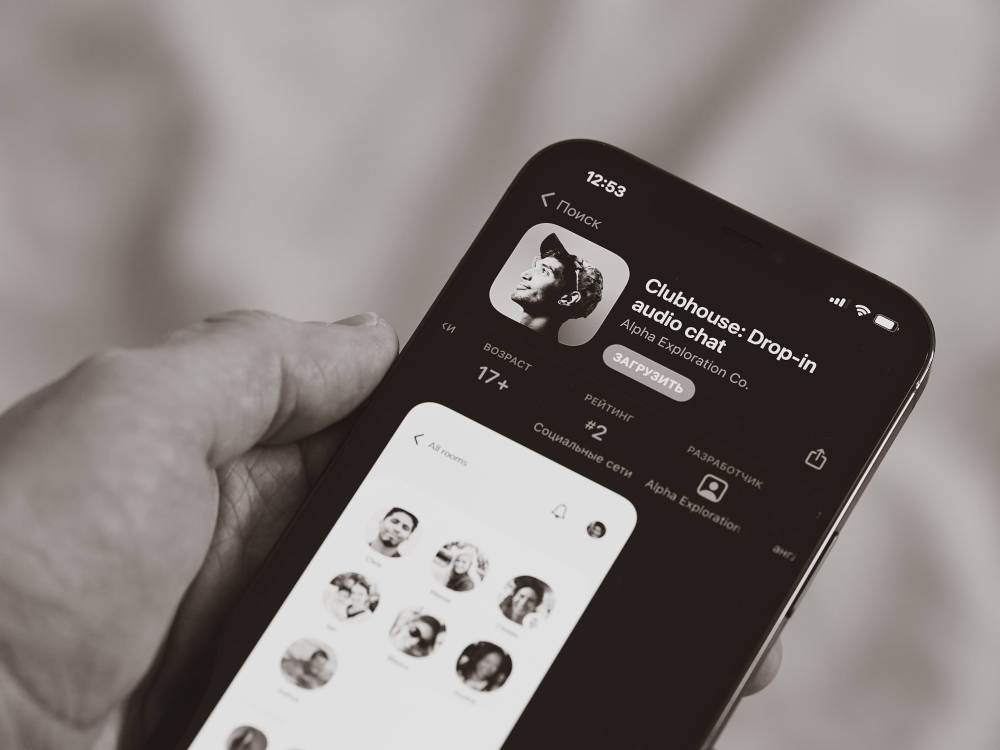[Photo by Dmitry Mashkin on Unsplash]
Good morning,
By now you must have heard about the buzziest new social media app, Clubhouse. Elon Musk and Mark Zuckerberg were on it recently. Launched with about a thousand members only in May last year, it is already valued at $1 billion. Twitter has launched a rival, and Facebook is planning one soon.
It’s only on iOS right now, but an Android version will be out soon. There are sceptics (who believe its popularity will drop once we are out of the pandemic) and critics (who worry about its security features and content moderation).
Many things about Clubhouse are unlike any other social media we have experienced before. To state a few: it’s voice-based, ephemeral, can be consumed passively and when used well, anecdotes reveal it can be a powerful platform to engage with a wide range of people and get you a wide range of experiences.
Given these are early days, people are still finding their feet and discovering what works for them and what doesn’t. They are learning how they should curate and design their own clubhouse experience. It’s not as straightforward.
So, if you are looking to maximise your Clubhouse experience or are curious and want an inside look on why people love the app, today’s FF Recommends is for you.
Here are three members of the Founding Fuel community, who share with us what got them hooked, why they use it, and how they have designed their Clubhouse experience.
A place for high-quality conversations
By Suprio Guha Thakurta, partner at Accelero and ex-chief strategy officer, The Economist Group
I got hooked on Clubhouse thanks to the diversity of topics being discussed and the quality of discussions in various rooms. Any drop off in the quality would reduce my interest. There is a sense of calmness about the experience that stands out in stark contrast to other social media platforms.
I have started following a few ‘clubs’. One of those is the Marketing Club. The topics are interesting and the competence and experience of the moderators and speakers on stage are almost always top-notch. Its moderators are US-based. That suits me as I log in later at night, check in and listen. While doing so, if I spot any other interesting group, I go in there and check it out.
I avoid the hardcore Silicon Valley VC/entrepreneur rooms. There are many as that is where CH started. Then, the good thing is you can choose your own rooms and clubs and it is pretty easy to avoid what you don’t enjoy.
Getting connected: For me, it’s clearly a way to network and build my personal brand. This is aligned to my objectives for my consultancy as I am always looking for business leads and partners in different geographies like the UK and the US. I have been amazed how many people I have connected with in the last few weeks and more so by their willingness to not only give advice in the room, but to connect offline and speak with you on whatever you are searching answers for. This giving culture has caught me, pleasantly, by surprise.
What continually strikes me in the groups I go to is the politeness. It is so different from, say, Twitter. Maybe, it’s because you are real there. It’s your voice, your bio for everyone to see. I like the structure of the stage, and listeners. It gives control to moderators as well as allows introverts to passively listen without feeling the pressure to participate. And all you have to do is raise your hand to participate actively.
I am in Clubhouse every evening around 9 pm or so and spend an hour-and-a-half. The first few days I may have logged more than five hours daily. Initially, I did listen in during my morning walks but have stopped doing that now and gone back to listening to my podcasts as I don’t want to have to switch between rooms. The other reason is that as I spend time in CH and people recognise me, they sometimes send me requests to join on stage and I miss the prompt as the phone is in the pocket and it’s pretty rude not to respond to requests like that.
Engaging on Clubhouse: I have a clear time of day (in the night!) on weekdays that I check in. In the beginning I focused on finding interesting rooms/clubs (based on the labels). One can find them by simple searches. Once I found a few clubs/rooms I liked, I started following people who sounded knowledgeable and had complimentary experiences and skills to mine. I have my notifications on, so I get an alert when any of the clubs or people I follow start a room. They sometimes invite me to join at the start, though that takes a bit of time to happen.
I would advise people to put up their ‘hand’ (this shows you are interested in speaking) when they feel they have either something interesting to contribute to the topic on hand or have an interesting question to ask. That is when you get noticed and people start following you. And that is how your network grows. One last thing: you must connect your bio to twitter or Instagram or both. There is no other way for anyone to connect with you otherwise. There is no DM on CH.
Your business can benefit from a community platform
By Sandeep Todi, co-founder & chief business officer at Truly Financial & Remitr
If you are running a business that can benefit from community platforms, Clubhouse can be useful. It does require an investment of time and planning, more so because it needs a “lean forward” participation, unlike a social feed timeline which is more “lean back”.
An easy path to immersion: Clubhouse has created an intimacy around social media which has been missing from all the large platforms. It defied the metaphor of “post and reply” by herding people into a room and tapped into the need for spontaneity which has been missing from all social platforms.
The best part about it is the minimal effort required to create or join conversations, and the immersive nature, which is the exact opposite of all other social networks, which thrive on overloading you with conversations and creating more and more distraction.
Just like any online community it has its pros and cons. On the good side, there are small communities that you can join, and meaningfully participate in conversations. It creates a great leveller because every person in a group or room has a chance to be as active or as passive as they like to. However, some of the groups have become so large and diverse that they tend to become unattractive. For the very broad topics, sub-groups may be the way to go in order to scale Clubhouse and keep the experiences meaningful.
Making time for Clubhouse: Initially, when I joined, I was quite sceptical about it but over the past few weeks I've joined groups that I'm interested in, related to marketing, B2B, Fintech etc, and also some personal interest groups related to climate change. It's becoming more habitual for me and now
- I have moved the icon to my home screen
- I track events that I like, and add them to my calendar. I like to participate fully in conversations and not multi-task as you cannot immerse in the topic if you don't focus.
- Sometimes I do it while walking (around the house).
- Saturday events seem to work well for me, as well as late evening, so it does not take away from my work day.
- Once a week or two, I will participate in a daytime event as well, especially fintech-related.
Creating durable value: It's easy to get lost in Clubhouse and the key is:
- Find / follow users whose opinions you value or know very well. Clubhouse keeps notifying you about who joined which room and you do want to make sure you are not receiving too many distracting notifications.
- Connect with other people who are speaking or are the moderator, to help and/or create meaningful value for myself.
- It's very important to curate what rooms you want to be in. I have joined far too many and that's just the process of me figuring out where the most value lies for me
- Get to know a few “strangers” well, and if you like what they do, it can quickly become a good contact where you can help each other mutually (on and off Clubhouse)
Creating durable value is most important and this can make you keep looking forward to Clubhouse meetings and using it in ways to advance your own interests, while also helping others.
The return of oral tradition
By NS Ramnath, Founding Fuel
The first conversation I listened to after I joined Clubhouse in the first week of January this year was Good Times, curated by Sriram Krishnan and Aarthi Ramamurthy. It felt like I was listening to a fun after dinner conversation by a bunch of smart people, commenting on the day’s biggest news in tech. It was mostly US centric. But soon, there were more people from India joining in, and there were conversations around Indian tech and startup scene. At the same time, as I explored I found a whole range of discussions—around art, music, culture and spirituality.
I had some sense of why I found it fascinating, but my colleague Kavi Arasu explained, voice is far richer than text, because the tonality can convey emotions in a way written text cannot (at least for most of us). In a video on the other hand, there is a danger of giving out more than you intend to (as video-on Zoom conversations showed us during the lockdown). As sociologist Zeynep Tufekci puts it in her recent newsletter, “It’s the latest encroachment of oral culture back into the public sphere.”
The corridors of Clubhouse University: It’s tempting to think of Clubhouse as a live podcast. In some cases, it’s effectively that—two or three people sharing what they have already figured out to a large audience. However, often, the discussions on Clubhouse are conversations in the true sense of the term—a group of people trying to figure out what’s going on, to make sense of the world, sharing their ‘work in progress’ thoughts, giving us a view of how ideas emerge and grow.
Discovery and discipline: Looking back, I realise I went through two phases—discovery and discipline. The first couple of weeks, I spent a lot of time, often running late into nights, jumping from one room to another, sometimes staying back to listen in to a discussion till the end, trying to discover what’s interesting. In the last two weeks, however, I have turned off notifications, and have become far more selective on what I listen to. My entry points tend to be Twitter (interesting people on Twitter tend to be even more interesting on Clubhouse, because they are not constrained by the text format), alerts from friends usually on WhatsApp, and the scheduled conversations (available on Clubhouse itself).
The Social Window

Tell us what you think and find noteworthy.
And if you missed previous editions of this newsletter, they’re all archived here.
Bookmark Founding Fuel’s special section on Thriving in Volatile Times. All our stories on how individuals and businesses are responding to the pandemic until now are posted there.
Warm regards,
Team Founding Fuel

